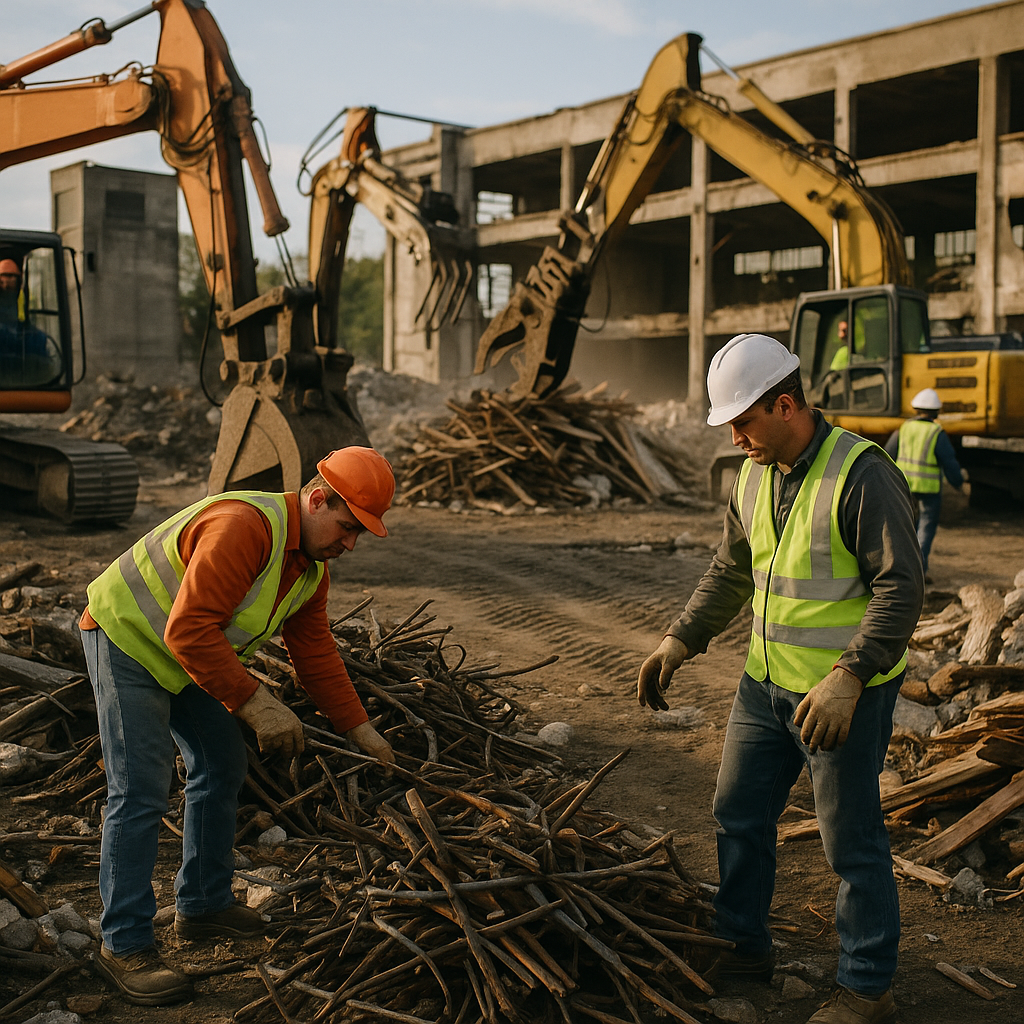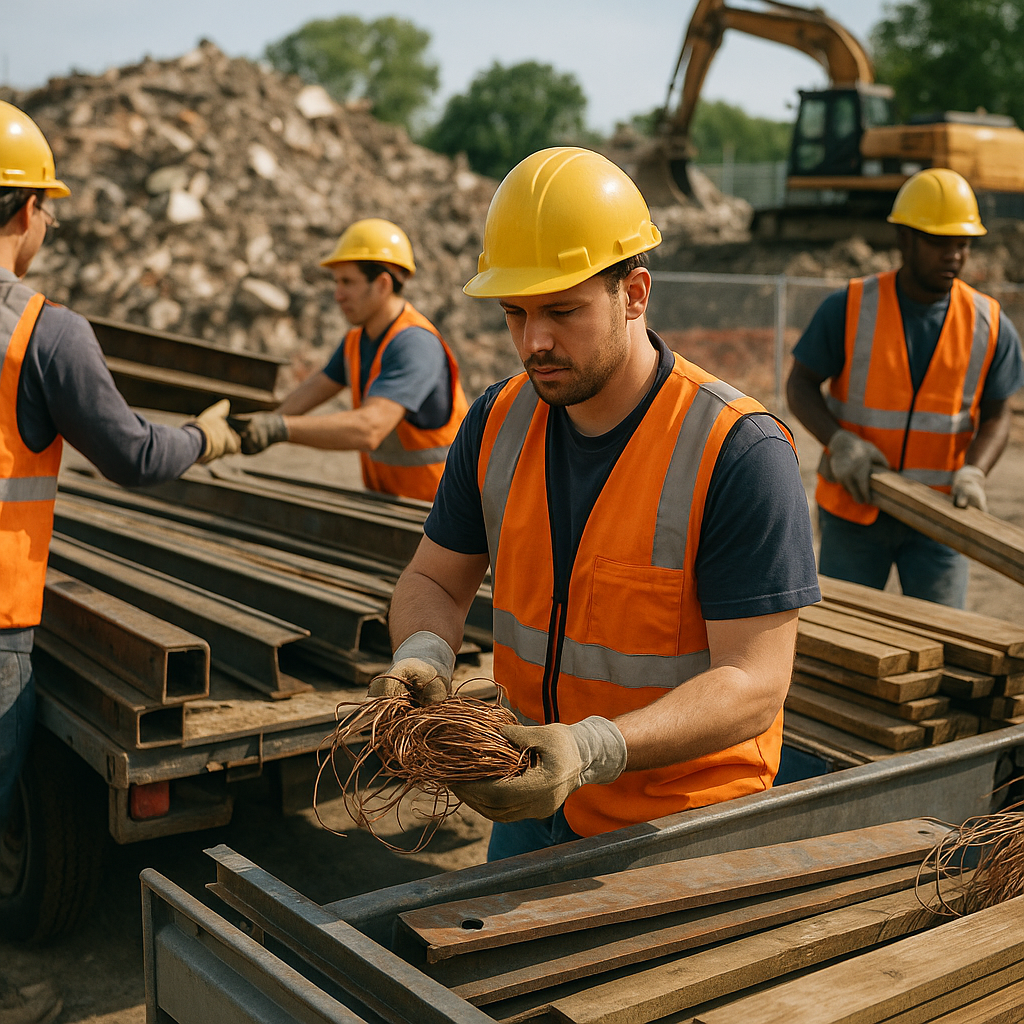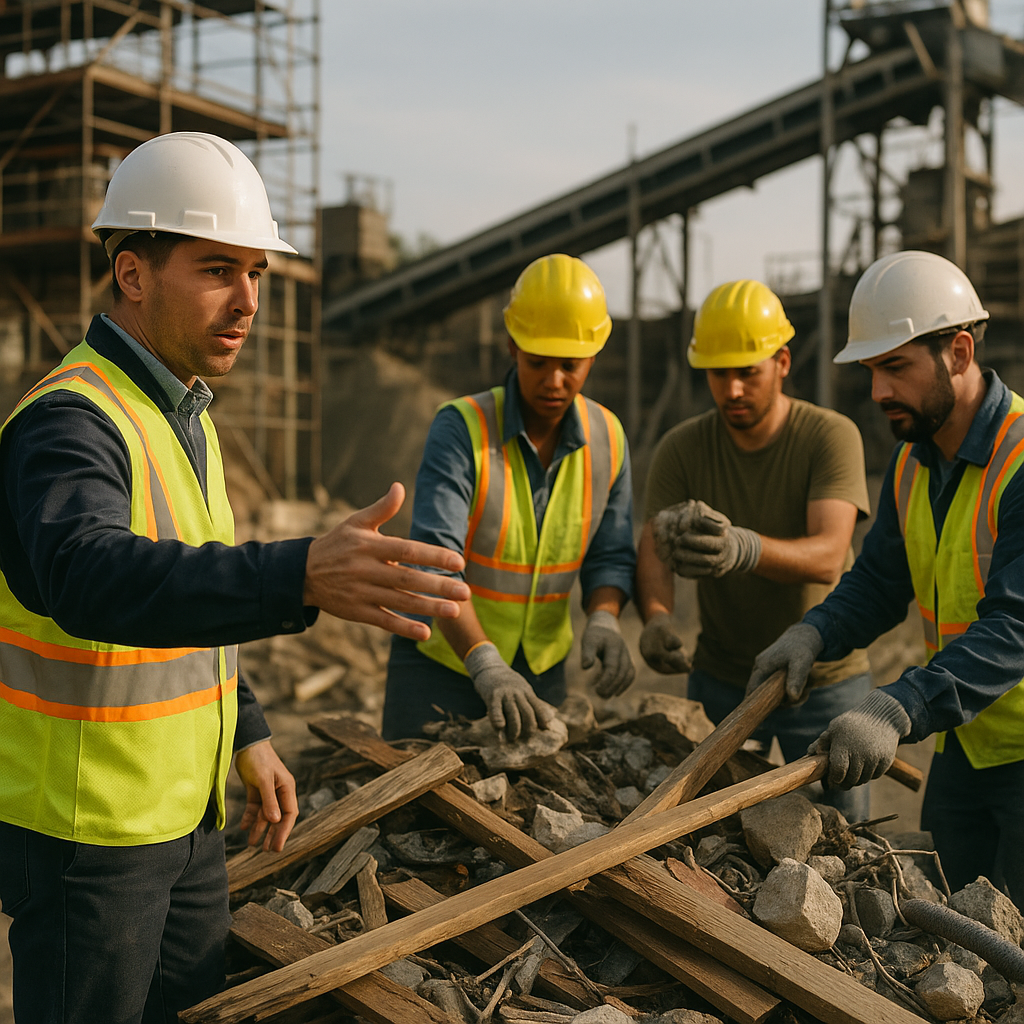5901 Botham Jean Blvd, Dallas, TX 75215
The Importance of Separating Recyclables During Plant Demolition
August 6, 2025Each year, the United States generates approximately 600 million tons of construction and demolition waste, making it one of the largest waste streams in the country. When plants and industrial facilities reach the end of their useful life, the demolition process creates enormous quantities of materials that often end up in landfills.
Separating recyclable materials during plant demolition is crucial, yielding multiple benefits. By segregating materials like concrete, steel, wood, and glass at the site, we can divert significant waste from landfills. This separation process helps conserve our limited landfill capacity and reduces the environmental impact of demolition activities.
In addition to environmental benefits, effective material separation offers economic opportunities. Recycled concrete can be used as aggregate for new construction projects. Salvaged steel has considerable market value, and wood can be repurposed or processed into new products. By employing strategic separation practices, materials once considered waste transform into valuable resources, creating jobs in the recycling sector and reducing the need for new materials in manufacturing and construction.
What Materials Can Be Recycled from Plant Demolition?

Plant demolition sites yield numerous valuable materials that can be diverted from landfills. When properly separated and processed, these materials are vital resources in the circular economy. The recycling potential varies by material, with some offering high recovery rates while others need more specialized handling.
Proper planning and material separation are crucial for successful recycling. Mixing materials during demolition can contaminate otherwise recyclable components and decrease their value. Strategic demolition approaches that emphasize careful material separation create the best opportunities for resource recovery.
- Metals (Ferrous and Non-Ferrous) – Steel, aluminum, copper, and brass are highly valuable in recycling markets. Steel has recycling rates of up to 98% for structural components, though steel embedded in concrete (rebar) has lower rates of about 71%. Metals can be melted and reshaped without quality loss, making them infinitely recyclable.
- Concrete and Masonry – These materials can be crushed and repurposed as aggregate for new construction projects, roadbeds, driveways, and retaining walls. Properly processed recycled concrete reduces the need for new aggregate extraction. The main challenge is removing contaminants and ensuring correct separation from other materials.
- Wood – Salvaged timber can be processed into engineered wood products, furniture components, particle boards, pallets, and mulch. Clean wood waste holds the highest value, while painted or treated wood may have more limited recycling options.
- Asphalt – Both roofing materials and pavement can be recycled. Asphalt pavement is among the most recycled materials in construction, with 90-100% of reclaimed material usable in new paving projects. Recycling asphalt saves American taxpayers an estimated $2.5 billion annually.
- Gypsum/Drywall – When kept intact during demolition, drywall can be effectively recycled. The paper facing is processed like other paper products, while the gypsum core can be recycled without performance loss. Recycled gypsum is used in agriculture and new drywall manufacturing.
- Glass – Clear, uncolored glass has the highest recycling value and can be reprocessed to virgin quality. Colored, treated, or laminated glass generally has fewer recycling options but can be downcycled as aggregate in decorative concrete or ceramic countertops.
- Plastics – Various plastic components from plumbing, insulation, and other systems can be recycled based on resin type. Clean, single-polymer plastics have the highest recycling value.
- Fixtures and Appliances – Doors, windows, and appliances can often be removed intact for direct reuse or component recycling. These items provide value through reuse rather than material recovery.
Many construction managers are surprised by the economic benefits of recycling plant demolition materials. Beyond avoiding landfill fees, recycling can generate revenue from valuable commodities like metals. Additionally, using recycled content supports sustainability initiatives and can qualify projects for green building certifications.
The environmental benefits of recycling plant demolition materials extend beyond waste diversion. By recovering and reusing these materials, we reduce the need for raw material extraction, decrease energy consumption for manufacturing new products, and minimize the carbon footprint associated with demolition activities.
How Are Recyclable Materials Separated During Demolition?

The demolition process generates significant waste that can be recycled and repurposed instead of being sent to landfills. Effective separation of these materials is crucial for maximizing recycling rates, involving both on-site sorting at the demolition location and off-site processing at specialized facilities. Here’s how these complementary approaches work to recover valuable resources from demolition waste.
On-Site Sorting Methods
On-site sorting involves separating recyclable materials directly at the demolition site before they are transported elsewhere. This approach yields higher-quality recyclables with less contamination, typically resulting in better recycling rebates and environmental outcomes.
The most common on-site sorting method utilizes multiple designated containers for different material types. Contractors place separate dumpsters for concrete, metal, wood, and other recoverable materials around the demolition site. Workers then sort materials as they are removed from the structure, placing each type in its appropriate container.
Worker training is essential for effective on-site sorting. Demolition crews must quickly identify different materials and know which container to use for each type. This training should cover not only material identification but also proper handling techniques to preserve quality and prevent contamination between waste streams.
Some larger demolition projects implement dedicated sorting stations where materials are examined and separated after initial removal from the structure. These stations often include conveyor systems where workers manually sort materials before placing them in designated containers. This method is particularly effective for mixed demolition debris that requires more careful separation.
Off-Site Processing Technologies
Once materials leave the demolition site, they undergo further processing at specialized recycling facilities. These facilities employ advanced technologies to sort, clean, and prepare materials for recycling. Off-site processing is particularly valuable for handling commingled waste or materials not fully separated on-site.
Magnetic separation is one of the most common technologies used in off-site processing. Strong overhead magnets are positioned above conveyor belts carrying mixed demolition waste. These magnets pull out ferrous metals like steel while leaving non-magnetic materials behind. This simple technology can efficiently recover large quantities of recyclable metals from mixed debris streams.
For non-ferrous metals like aluminum and copper, recycling facilities use eddy current separators. These devices create a rapidly changing magnetic field that induces electrical currents in non-ferrous metals, causing them to separate from the conveyor belt while other materials continue forward. This sophisticated technology allows for the recovery of valuable non-ferrous metals that magnetic separation would miss.
Optical sorting systems represent advanced recycling technology. These systems use cameras and sensors to identify materials based on visual properties. When the system detects a specific material type, it triggers a precise blast of air to push that item into the appropriate collection bin. Optical sorters can distinguish different types of plastics, various colors of glass, and even different grades of wood, making them invaluable for processing complex demolition waste.
Density separation techniques use water or air to separate materials based on weight and buoyancy. In water-based systems, heavier materials sink while lighter ones float, allowing for efficient separation. Air classifiers use controlled airflow to lift lighter materials while leaving heavier ones behind. These methods are particularly useful for separating wood from heavier construction materials.
The Balance Between On-Site and Off-Site Approaches
The decision to emphasize on-site or off-site sorting depends on several factors specific to each demolition project. Space constraints often play a decisive role. Urban demolition sites with limited space may not have room for multiple sorting containers, making off-site processing more practical.
Project timelines also influence the approach. On-site sorting requires more time for setup and training but can yield higher-quality recyclable materials. Projects with tight deadlines might rely more heavily on off-site processing despite potentially lower recycling rates.
Cost considerations are important as well. On-site sorting typically requires more equipment and labor but can generate better recycling rebates. Off-site sorting generally offers lower upfront costs but may result in less revenue from recycled materials.
Many successful demolition projects use a hybrid approach, conducting basic sorting on-site for easily separated materials like concrete and metal while sending more complex mixed materials for off-site processing. This balanced approach often provides the best combination of efficiency and recycling rates.
Specialized Equipment for Material Processing
Beyond the sorting technologies, specialized equipment is used to process specific materials after separation. Mobile crushers process concrete and masonry on-site, reducing transportation needs and creating ready-to-use aggregate for new construction. Wood chippers transform lumber into mulch or biomass fuel. Metal balers compress separated metals into dense blocks for efficient transport to smelting facilities.
Technology for processing demolition waste continues to advance. New sensor technologies are improving the accuracy of optical sorters. Artificial intelligence systems are being developed to better identify complex materials and make real-time sorting decisions. These innovations promise to further increase recycling rates from demolition projects in the coming years.
Benefits of Separating Recyclables During Plant Demolition

The strategic separation of recyclable materials during plant demolition offers advantages beyond simple waste reduction. Organizations that implement recycling during demolition projects reap benefits across financial, environmental, and social areas.
Cost Savings and Revenue Generation
Separating recyclables during plant demolition significantly reduces disposal costs. Landfill fees rise as space becomes scarce. By recycling, companies can cut disposal expenses by up to 50%.
Recycling also provides potential revenue. Many materials in industrial plants have market value when sorted. Metals like steel, copper, and aluminum can be sold, turning waste into profit. A medium-sized demolition project can recoup thousands through the strategic sale of recyclables.
The financial benefits are clear when comparing traditional disposal with recycling. For a project generating 500 tons of waste, landfill disposal might cost $25,000-$35,000 in fees alone. A recycling program could reduce this to $10,000-$15,000 and generate $3,000-$8,000 in sales, totaling a financial benefit of $18,000-$28,000.
Conservation of Natural Resources
Recycling materials during demolition reduces demand for new resources. When steel, concrete, and glass are recycled, the need for extracting and processing raw materials diminishes, creating lasting environmental benefits.
The resource savings are substantial. Recycling one ton of steel saves about 2,500 pounds of iron ore, 1,400 pounds of coal, and 120 pounds of limestone. Similarly, recycling concrete reduces the need for new aggregate, and reclaimed wood lessens pressure on forests.
Resource conservation also extends to energy savings. Manufacturing with recycled materials typically requires much less energy than using raw materials. For instance, recycling steel requires 60% less energy than producing it from virgin materials, directly translating to reduced carbon emissions and a smaller environmental footprint.
Environmental Impact Reduction
The environmental benefits of separating recyclables during demolition are extensive. Recycling reduces landfill use. A single demolition project can divert thousands of cubic yards of debris, preserving landfill capacity.
Reducing the carbon footprint is another benefit. Producing construction materials is energy-intensive, generating substantial emissions. By reusing existing concrete as aggregate, companies avoid these emissions and preserve the carbon already invested in these materials.
Water conservation also benefits from recycling practices. Producing new materials typically uses substantial water resources. For example, making one ton of virgin steel consumes around 60,000 gallons of water, which recycling significantly reduces.
Additionally, separating and recycling hazardous materials during demolition prevents soil and water contamination. Proper management of materials with chemicals or toxins avoids improper disposal and environmental harm.
Job Creation and Economic Growth
Separating recyclables during demolition creates jobs and stimulates economic activity. The recycling sector generates jobs at various skill levels, from collection to manufacturing new products from recycled materials.
According to the EPA’s 2016 Recycling Economic Information Report, recycling construction and demolition materials created 175,000 jobs in 2012. These jobs provide stable employment and contribute to local economic development.
The economic benefits extend beyond job creation. Recycling operations support related businesses and services, creating a multiplier effect. Transportation services, equipment manufacturers, and technology providers all benefit from increased recycling.
Regulatory Compliance and Corporate Responsibility
Separating recyclables during demolition helps companies meet strict environmental regulations. Many areas now require minimum recycling rates for demolition projects. Non-compliance can lead to fines and delays. By implementing recycling programs, companies avoid these issues and demonstrate environmental responsibility.
Besides regulatory compliance, effective recycling enhances corporate reputation. As stakeholders prioritize sustainability, companies leading in waste reduction gain competitive advantages. This responsible approach can improve community relations, strengthen brand image, and attract eco-conscious clients and partners.
Organizations with visible recycling programs earn goodwill from local communities, easing future projects and reducing resistance to new developments. These intangible benefits often translate into tangible business advantages over time.
Challenges and Best Practices in Recyclable Separation

Effective separation of recyclables poses significant challenges for businesses across industries. Understanding these challenges and implementing best practices can determine the success or failure of a recycling program in meeting sustainability goals. Let’s explore the key obstacles and their solutions.
Common Challenges in Recyclable Separation
Contamination is a major barrier to effective recycling. When non-recyclables mix with recyclables, the entire batch may be rejected by processing facilities. Research across major American cities indicates contamination rates can reach up to 25% in typical recycling streams, costing material recovery facilities an estimated $300 million annually in additional labor and equipment repairs.
Space constraints are another challenge, especially in urban settings or facilities with limited square footage. Without adequate space for sorting stations, recyclables often end up in general waste containers, hindering separation efforts at the source.
Market volatility affects recyclable separation strategies. Local recycling markets vary widely in accepted materials and processing capabilities. What is recyclable in one region may not be in another, leading to confusion and inconsistency in separation practices. This inconsistency contributes significantly to sorting errors, with research showing error rates as high as 52% for materials accepted in some locations but not others.
Best Practices for Effective Recyclable Separation
Developing a comprehensive waste management plan is essential for successful recyclable separation. Begin with a waste audit to identify the types and volumes of materials your facility generates. This information allows you to tailor your separation strategy to your specific waste stream and set realistic goals for improvement.
Strategic bin placement and clear signage dramatically improve separation outcomes. Position recycling and waste bins together to make proper disposal as convenient as choosing the trash. Use consistent color coding throughout your facility—for example, blue for recycling, green for composting, and black for waste. Include clear visual guides indicating which items belong in each bin to minimize confusion.
Worker training is crucial for maintaining separation quality. Employees need to understand not just what goes where, but why proper separation matters. Regular training sessions keep recycling knowledge current and demonstrate your organization’s commitment to sustainability. Consider appointing recycling champions within different departments to monitor compliance and address questions from colleagues.
Establishing partnerships with reputable recycling facilities provides valuable insights into their specific requirements. These partners can offer guidance on how to prepare materials for optimal recovery and may conduct site visits to recommend improvements to your separation processes. Regular communication with your recycling partner helps you stay informed about changes in accepted materials or processing capabilities.
Implementing a Successful Separation System
Begin with a proper launch or relaunch of your recycling program. Have senior leadership announce the initiative and its importance to create buy-in across the organization. Make the kickoff memorable with an event that educates while generating enthusiasm for participation.
Maintain engagement through regular communication about program successes and challenges. Share metrics on diversion rates or contamination reduction to demonstrate progress. Celebrating milestones reinforces the value of everyone’s contribution to the program’s success.
Regular monitoring and assessment keep your separation system on track. Conduct periodic waste audits to measure improvement and identify areas needing attention. Be prepared to adjust your approach based on these findings, whether that means relocating bins, updating signage, or providing additional training.
Stay informed about changing regulations and market conditions that might affect your recycling program. Many local governments offer resources and guidance for businesses looking to improve their waste management practices. Industry associations and sustainability networks can also provide valuable information about emerging best practices in recyclable separation.
Overcoming Space Limitations
For facilities with limited space, creative solutions can maximize separation efficiency without requiring extensive floor area. Consider vertical storage options, such as stacked bins or wall-mounted sorting stations. Compactors and balers reduce the volume of collected materials, allowing for more efficient storage until pickup.
In some cases, centralizing recycling collection points rather than placing bins at every workstation can help manage space constraints while still providing convenient access for employees. Just ensure these central stations are strategically located near areas where recyclable materials are commonly generated.
When addressing space challenges, it’s important to involve facilities management in the planning process. They can provide insights about available space and help identify potential solutions that work within your building’s constraints while meeting fire safety and accessibility requirements.
By recognizing the challenges in recyclable separation and implementing these best practices, businesses can significantly improve their recycling outcomes. The key is to approach separation systematically, with clear processes, effective training, and ongoing monitoring to ensure continuous improvement. With commitment and the right strategies, even the most challenging separation issues can be overcome, leading to more sustainable waste management practices and reduced environmental impact.
Conclusion: Maximizing Recycling Potential in Plant Demolition

Separating recyclable materials during plant demolition is a crucial step toward sustainable construction and demolition practices. Effective separation strategies can significantly reduce waste, conserve natural resources, and create substantial value from materials that might otherwise end up in landfills. The economic benefits are equally compelling, ranging from reduced disposal costs to potential revenue from recovered materials, along with compliance with increasingly stringent regulations.
As sustainability requirements become stricter in the construction industry, maximizing recycling in plant demolition will be essential for competitive operations. The future of demolition involves viewing projects as material recovery opportunities rather than waste-generating activities. For your plant demolition recycling needs, contact Okon Recycling at 214-717-4083. Our expertise in metal recycling ensures your project meets sustainability goals while maximizing economic benefits.
